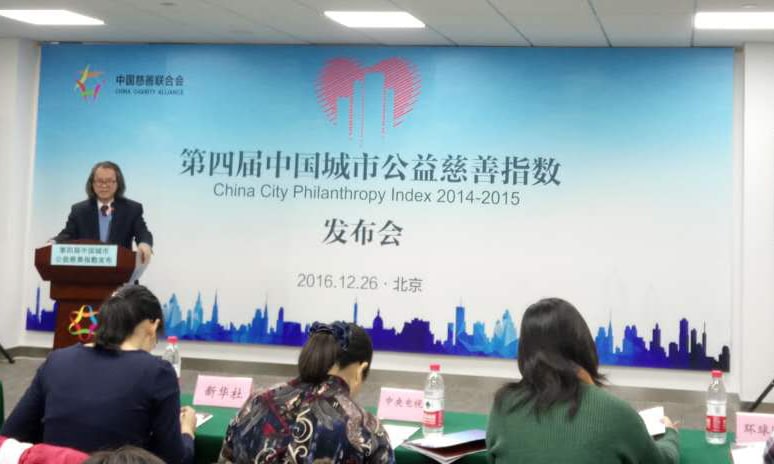
The China Charity Alliance recently released the “China City Philanthropy Index 2014-2015” in Beijing. The study shows that overall China’s urban philanthropy is flourishing, the amount of donations is steadily increasing, the number of volunteers is on the rise and social organisations are developing rapidly. Beijing, Shanghai, Nanjing and Guangzhou ranked among the top ten cities.
The “China City Philanthropy Index” is a set of indexing systems aimed at providing comprehensive monitoring and scientific evaluation of the regional development of Chinese charity. Its statistics and evaluations have received attention and recognition from society.
This year’s Philanthropy Index considers 51 different indexes based on six aspects: social donations, voluntary work, charity organisations, the voluntary sector’s contribution to GDP, government support and charitable culture. The Index evaluates the level of charitable development in 256 cities between 2014 and 2015, covering 87.5% of China’s provinces (autonomous regions and municipalities included), 39% of cities and 770 million people (56% of the overall population).
Between 2014 and 2015 the overall development of urban charity remained strong in areas like donations, the number of volunteers and social organisations. In 2015, the amount of donations in the cities investigated topped 46.3 billion, increasing by 6.28%; the number of volunteers reached 46.1 million, increasing by 9.87%; the number of social organisations reached over 467,900, increasing by 9.01%. It is also worth mentioning that community charities have received more attention and support from local governments. In 2015, community charities made up almost half of social organisations in the cities surveyed.
In regard to social donations, Nanjing, Xiamen and Wuxi ranked on top. Zhengzhou (Henan Province), Shanghai and Wuxi (Jiangsu Province) led the list for voluntary services. However, Beijing, Shanghai and Wuxi have ranked in the top three places for the number of volunteers registered for two consecutive years.
Nanjing, Beijing and Ningbo (Zhejiang Province) ranked first in the area of charity organisations; the top three cities for the voluntary sector’s contribution to GDP were Shenzhen, Beijing and Nanjing; Jinjiang (Fujian Province), Shenzhen and Shaoxing (Zhejiang Province) performed outstandingly for government support and Beijing, Shenzhen and Guangzhou maintained a competitive edge for charitable culture.
According to the statistics, disparities still exist between different regions of the country, but the central and western regions of China are working on bridging the gap. Since the amount of total donations is related closely to regional economic development, it is hardly surprising that out of the top 100 cities the numbers of eastern, central and western cities are 65, 20 and 15 respectively. In regards to voluntary services, the number of volunteers in the eastern regions reached 70.36% of the overall cities surveyed, but it should be noted that the western regions have far less people. The proportion of volunteers in the western regions is 6.27% however, only 2% lower than in the eastern regions and 3% higher than in the central regions. 17 cities in the eastern regions ranked in the top 20 for the number of social organisations, alongside only one from the central regions and two from the western regions.



